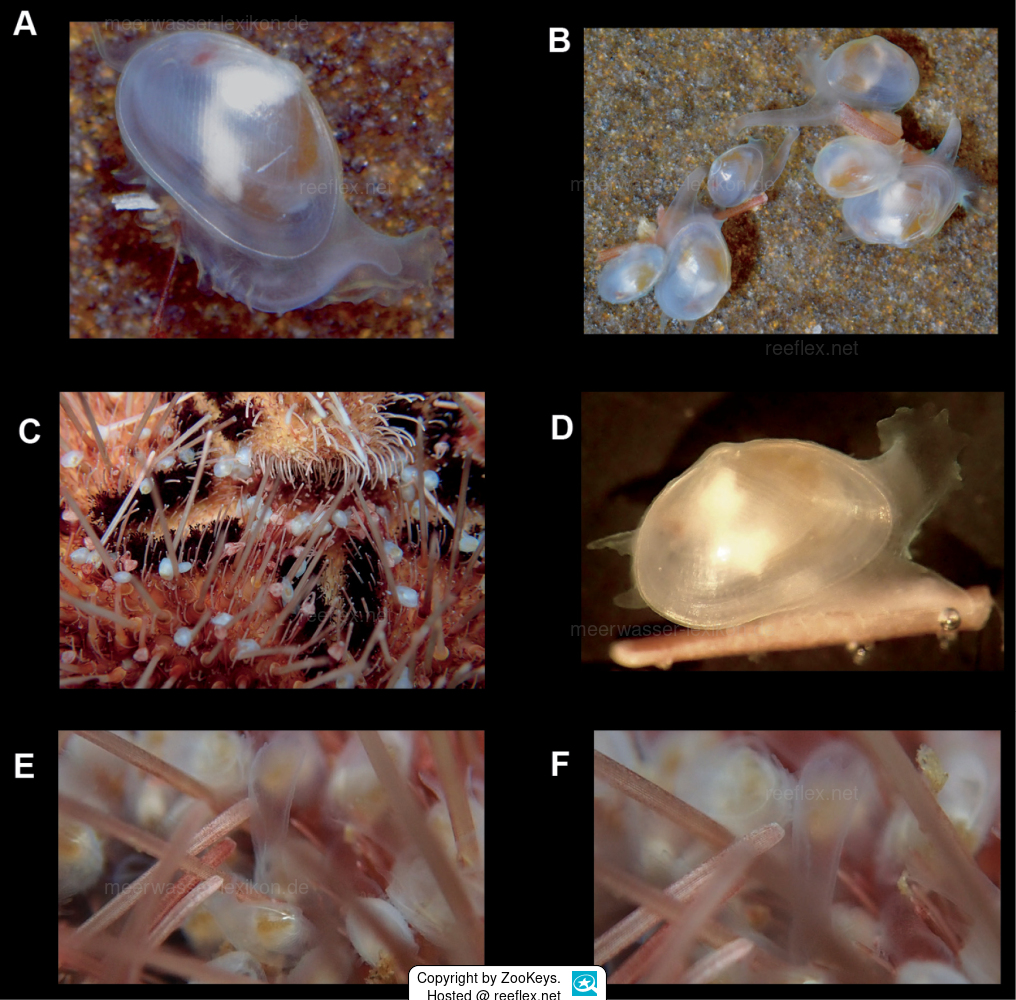Info
Brachiomya ducentiunus is so far only known from the type locality in False Bay, South Africa, and has only been found on the sea urchin Spatagobrissus mirabilis; free-living mussels have not been observed.
This species was first discovered in 2016 by free divers at the type locality, collected by Jannes Landschoff and Craig Foster.
The mussel is preferably found attached to the spines or crawling between the spines of Spatagobrissus mirabilis.
The mantle of the clam is large, reflective, and covers ~95% of the outer shell surface when fully extended.
The mantle can be almost completely retracted into the shell. The tentacles show a large cap at the front end and they are serrated at the end.
The shell of the mussel is extremely thin, fragile, moderately inflated, translucent; unequal-sided, slightly longer towards the front; ovoid-elongated.
The front end of larger specimens is obliquely truncated, the rear end broadly rounded.
The host species Spatagobrissus mirabilis lives in a specialized microhabitat of coarse gravel and half-buried stones or boulders (at least at the type locality in association with kelp forests).
At the type locality in 2018, all 10 sampled heart urchins had Brachiomya on their mouth surface.
The density of Brachiomya ranged from 38 to 172 specimens on a single host.
Two other commensal species were also detected on the same sea urchins: a small but very common, non
Literature reference:
Valentich-Scott P, Griffiths C, Landschoff J, Li R, Li J (2024)
Bivalves of superfamily Galeommatoidea (Mollusca, Bivalvia) from western South Africa, with observations on commensal relationships and habitats.
ZooKeys 1207: 301-323. https://doi.org/10.3897/zookeys.1207.124517
This species was first discovered in 2016 by free divers at the type locality, collected by Jannes Landschoff and Craig Foster.
The mussel is preferably found attached to the spines or crawling between the spines of Spatagobrissus mirabilis.
The mantle of the clam is large, reflective, and covers ~95% of the outer shell surface when fully extended.
The mantle can be almost completely retracted into the shell. The tentacles show a large cap at the front end and they are serrated at the end.
The shell of the mussel is extremely thin, fragile, moderately inflated, translucent; unequal-sided, slightly longer towards the front; ovoid-elongated.
The front end of larger specimens is obliquely truncated, the rear end broadly rounded.
The host species Spatagobrissus mirabilis lives in a specialized microhabitat of coarse gravel and half-buried stones or boulders (at least at the type locality in association with kelp forests).
At the type locality in 2018, all 10 sampled heart urchins had Brachiomya on their mouth surface.
The density of Brachiomya ranged from 38 to 172 specimens on a single host.
Two other commensal species were also detected on the same sea urchins: a small but very common, non
Literature reference:
Valentich-Scott P, Griffiths C, Landschoff J, Li R, Li J (2024)
Bivalves of superfamily Galeommatoidea (Mollusca, Bivalvia) from western South Africa, with observations on commensal relationships and habitats.
ZooKeys 1207: 301-323. https://doi.org/10.3897/zookeys.1207.124517







 ZooKeys
ZooKeys

